Meet the White-throated Kingfisher, a splash of colour with a beak full of surprises! Found across India and much of Southeast Asia, this bird is not just another pretty face perched on a wire. With brilliant blue wings, a rich chestnut body, and a dazzling white throat, the White-throated Kingfisher is both bold and beautiful.
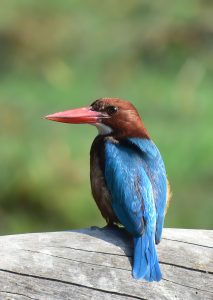
But it’s not just looks that make this bird special. It’s a skilled hunter, a surprisingly adaptable city-dweller, and one of the easiest kingfishers to spot, even far from water!
How to Identify White-throated Kingfisher
The White-throated Kingfisher is a medium-sized bird, typically measuring around 27–28 cm in length. Its standout appearance makes it hard to miss:
| Electric blue wings, back, and tail |
| Rich brown (almost reddish) head, chest, and belly |
| A clear, white patch on the throat and chest |
| A large, bright red beak and matching red legs |
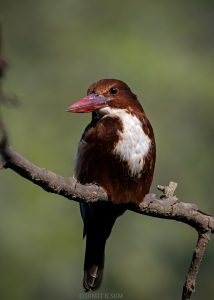
Males and females look almost identical, so you’ll need to observe behaviour rather than plumage to tell them apart. Juveniles appear a little duller in colour, but still carry the species’ characteristic markings.
In flight, keep an eye out for white patches on the wings — a signature detail that gives them away mid-air.
Distribution and Habitat of White-throated Kingfisher
Despite the name “kingfisher,” this species isn’t always found near water. That’s one of the things that sets it apart.
The White-throated Kingfisher is widespread across the Indian subcontinent and extends its range east into parts of Southeast Asia. In India, it’s as much at home in bustling cities as it is in rural farmland or wooded areas.
You’ll find it in:
| Urban gardens and rooftops |
| Forest clearings and farmlands |
| Wetlands, riversides, and lakes |
| Even dry scrubland and grasslands |
From sea level up to the lower Himalayan foothills, this bird has made itself comfortable in a remarkable variety of environments just like purple sunbirds.
White-throated Kingfisher’s Behaviour and Diet
This kingfisher is a classic example of “sit-and-wait” hunting. It often perches quietly on a wire, branch, or fence post, watching intently for movement below. When it spots prey — swoop! Down it dives with precision.
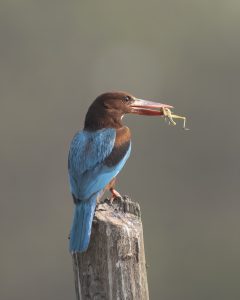
Despite the name, fish isn’t its main food. This kingfisher has a varied menu:
| Insects | Like beetles, crickets, and grasshoppers |
| Reptiles | Especially lizards |
| Amphibians | Frogs are a favourite |
| Small mammals and birds | When the opportunity arises |
| Crustaceans and fish | Mostly near water bodies |
Its strong beak helps it tackle a wide variety of prey, and its hunting skills are surprisingly effective in both urban and wild settings.
Read about Sarus Cranes
Breeding and Nesting Habits of White-throated Kingfishers
The breeding season usually kicks off with the arrival of the monsoon — a time of abundance. You’ll often hear the loud, staccato calls of males ringing through the air as they claim territory and try to attract a mate.
Nesting takes place in burrows. These are dug into soft earth banks, road cuts, or even abandoned termite mounds. A pair may take turns excavating the tunnel, which can be more than a metre deep!
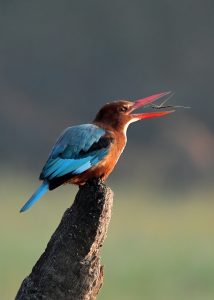
Key Breeding Facts about White-throated Kingfishers
| Nesting site | Earth banks, mud walls, and termite mounds |
| Clutch size | Typically 4 to 7 eggs |
| Incubation | Both parents share duties |
| Fledging | Chicks leave the nest about 3–4 weeks after hatching |
The chicks are altricial — that means they hatch blind and featherless, relying entirely on their parents for food and warmth in the early days.
White-throated Kingfisher’s Conservation Status
The White-throated Kingfisher is doing well — in fact, very well. It’s currently listed as Least Concern on the IUCN Red List, thanks to its wide range, healthy population, and remarkable adaptability.
That said, like many species, it still faces threats in areas with excessive pesticide use or habitat loss. But overall, it’s a conservation success story — a bird thriving in both nature and human-dominated landscapes.
Fun Facts about White-throated Kingfishers
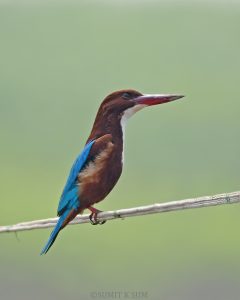
- It’s not shy! Unlike many birds, this kingfisher is bold and often seen out in the open, perched proudly on wires or walls.
- It’s a noisy neighbour. The call is a loud, chuckling series of notes — hard to miss, especially during the breeding season.
- It’s more than a fisher. While its cousins prefer rivers and lakes, this species happily dines away from water.
- It’s a favourite of photographers. With such vivid colours and a habit of staying still on open perches, it’s often a birdwatcher’s first “wow” moment.
The White-throated Kingfisher is a charismatic and colourful ambassador of India’s birdlife. Whether you’re strolling through a city park or trekking through rural fields, there’s always a chance to catch a glimpse of this bright bird watching the world from a perch.
So next time you hear a loud, laughing call or see a flash of blue wings dart across the sky, take a moment. You just might be in the company of a king.
🪶 You May Also Like
- Common Kingfisher – The Blue Jewel of Rivers
- Indian Pitta – The Monsoon Visitor
- Spotted Owlet – The Tiny Night Guardian
| Get your favourite White-throated Kingfisher photograph framed for your wall – Request Now @+91-9540178459 |
